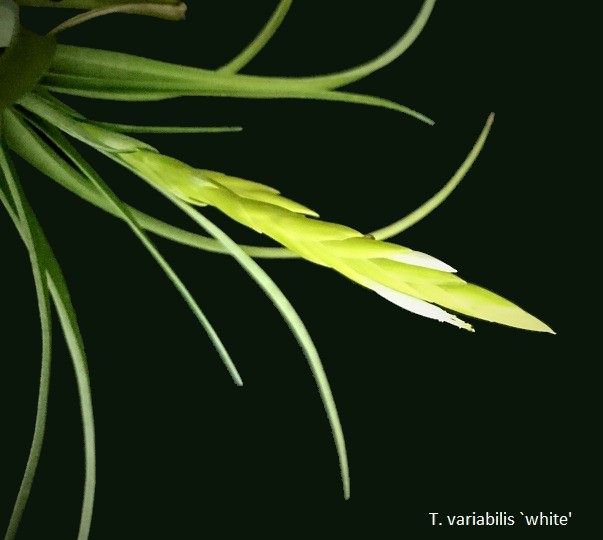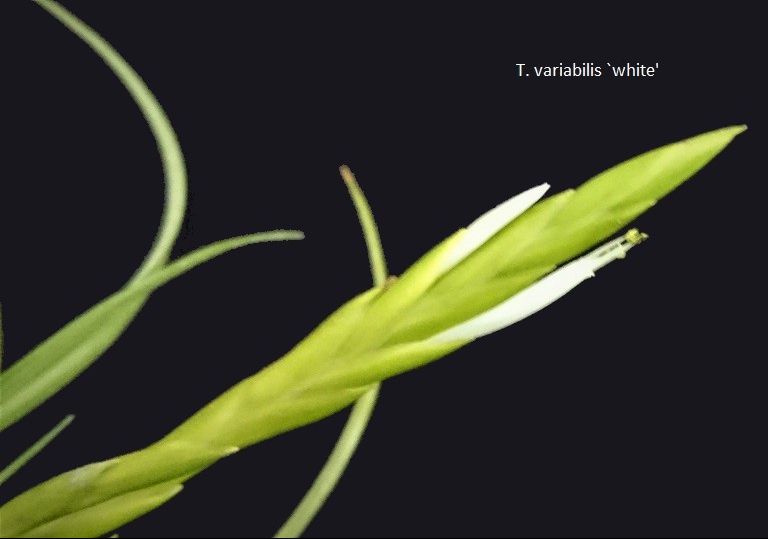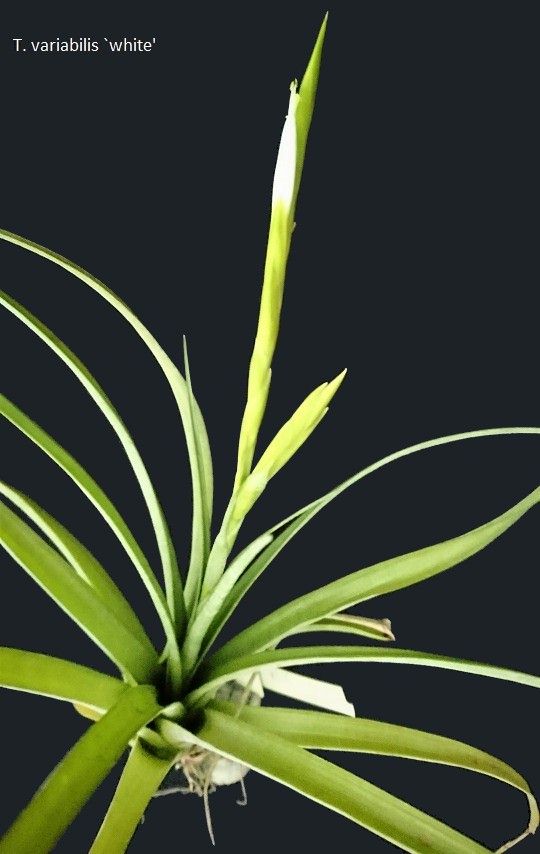Tillandsia Cartago
Click thumbnails for full size, scaled to a new window.
Tillandsia Cartago
Affinity to T. variabilis
From BCR - "Leaves robust, clearly recurved, glaucous, bracts pale red. (green in cultivation? – Butcher) Costa Rica in valley of Turialba, on trees, alt. 800 m (no. (1114) 13 Jan 1882, in state of flowering. Differs from typical species by having smaller leaves, sepals short, 2/3 as long as the bract and flowers white. Clear affinity with T. kunthiana, (now treated as a synonym of T. variabilis – Butcher) but more lepidote. Near to flower colour to T. distachya Bak. (Still not aligned and treated as excluded taxa in Encyclopaedia – Butcher) Also close. Reg. Doc. 7/2017 by D Butcher. Country of origin: Costa Rica


 Originally shown on this website as T. variabilis "alba" or "white", with subsequent discussions as shown below.
Originally shown on this website as T. variabilis "alba" or "white", with subsequent discussions as shown below.
Steve Molnar ... "This is one I got from Neville Ryan a year or two ago, and it is finally big enough to flower. I'm liking the look of this plant due to it's lush green leaves and now these crisp white flowers. I just hope it seeds just as well as the regular variety."
Peter Tristram ... "One ‘alba’ that I don’t have! Neat plant too. Did Nev grow it from seed?"
Chris Larson ... "This is my normal form – and I quite like it. Though green plant, green spike, & white flower don’t make it stand out. How much of this one do you want? Not sure where Collector's Corner got it – but it produces seed and germinates like crazy, and comes up in pots amongst my collection in the heated houses. Could have been from Rolly Reilly or from o/s. Doesn’t like the weather here at home, though. That makes short work of it!"
Steve Molnar ... "I'm happy to keep it growing up here as it seems to love the climate. I cannot seem to find it in the regular places. Is this one registered or anything? Just want to make sure I have the name right."
Tillandsia ‘Cartago’ by Derek Butcher July 2017
In June 2017 it became known that the white petalled form of Tillandsia variabilis was quite common in Australia and yet was a closely guarded secret. This investigation is due to a questioning posting by Steve Molnar on the internet.
We know that white petalled flowers occur in nature when the normal colour is purple/lilac but they should be recorded. Sometimes they are described under the botanists rules (ICN) as say, forma alba.
Sometimes they are ignored such as Tillandsia variabilis in Smith & Downs (1977) where we see petal colour as lilac or violet even though in the list of synonyms there is Tillandsia polystachia Linnaeus var alba Wittmack, Bot. Jahrb. 11: 65. 1889.
Type. Costa Rica, Lehmann 1114 (n v, fide Mez). But most times this ‘albinism’ is seen as of interest to the grower and as such, has a cultivar name so that details can be recorded in the BCR. Alba is a name frowned upon in the ICNCP rules but an even better name is ‘Turialba’ which is where this white petalled form was first found in 1882 in Costa Rica. However, there is already a ‘Turrialba’ (the modern spelling) registered in the BCR so ‘Cartago’ which is the province name has been selected.
28. T. polystachya L. var. alba Wittm.
Folia robusta, valde rccurva, glauca, bracteae dilute sanguineae.
Costa Rica in valle de Turialba, ad arbores, alt. 800 m (no. (1114) 13 Jan 1882, statu florente.
Differt a specic typica foliis minoribus, calyce breviore, 2/3 bracteae longitudinae et floribus albis. Valde affinis T. kunthianae, sed magis lepidota. Propter floris colorem ad T. distachyam Bak. Etiam accedit.
Translated by Butcher
Leaves robust, clearly recurved, glaucous, bracts pale red. (green in cultivation? – Butcher)
Costa Rica in valley of Turialba, on trees, alt. 800 m (no. 1114) 13 Jan 1882, state of flowering.
Differs from typical species by having smaller leaves, sepals short, 2/3 as long as the bract and flowers white. Clear affinity with T. kunthiana, (Now treated as a synonym of T. variabilis – Butcher) but more lepidote. Near to flower colour to T. distachya Bak. (Still not aligned and treated as excluded taxa in Encyclopaedia – Butcher).
How and when it arrived in Australia is a mystery but it seems to be well established in Queensland through Neville Ryan and in Victoria through Chris Larson.
Updated 27/08/17


